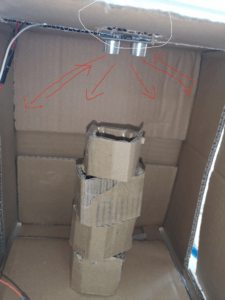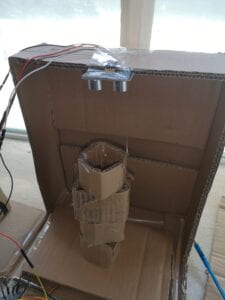Seismic Zone
Jade Wen and Robbin Wu
Instructor: Andy Garcia
In the previous Group Project, we did a device, which appeared as a pair of hands, that can create choreography according to their mood and lead people to dance once they touch it. It is a way for people to express their feelings in the form of art and we think it is interesting. Interaction plays an important role in this project because the communication between the robot and the user is constantly happening back and forth during the process. The robot reads the emotion, outputs the dance and the user receives the instructions. We use this concept of interaction in our midterm project. We created a board game, where players can build a building with blocks. Chances are that they may encounter earthquakes, which are simulated with the Arduino mechanism, that can destroy the building. Originally, we wanted to design something for professional urban planning. But a game is more interesting, and can engage a larger audience, from kids to adults. There are lots of table top designs and games that are intuitive for city-planning, but we want to add more on interactions with simulation of earthquakes and sounds. This kind of game is engaging within family and groups of friends, and also inspiring for children in the field of architecture, urban-planning, and engineering.
We chose an ultrasonic sensor because since we intend to let users build a skyscraper in order to win the game, we need something to detect the height of it. We want it to be a board game that is fun and easy to understand for a wide range of audience from kids to adults. So we included cards that remain the typical feature of a board game. There are four kinds of cards and each represents a different action for that round: adding another brick, triggering a small earthquake, a big earthquake, and the ultimate earthquake. Unknown to what they will expect, it becomes exciting. And also we added another feature for a way to inform and celebrate a player’s victory. When they hear the music from the buzzer, they know they have succeeded, and meanwhile, dance to it! The audio is better and more engaging than visuals such as a lightning LED.
During the code part, Robbin took charge of a big portion of it. The most difficult part that took lots of time was testing the range of the motor rotation. But all we needed to do was test it over and over again. The distance for the ultrasensor was in a similar situation as well, especially when we built the model separately, we had different numbers in the code and needed to test it several times. But Robbin was very helpful and approachable even though we could only contact each other online. In addition, when I built the model, I figured out the ultrasonic sensor was a big problem if I attached it in the cardboard box. First I made a hole on the top of the box that the sensor could fit in. But when I tested it, the buzzer made sounds even though the distance was further than the designated number in the code. I guessed it was because the ultrasound it sent bounced back when it hit the sidewall of the box, which led to the miscalculation. So I cut the box and made it a more open area so that the side of the box wouldn’t affect the soundwave.
Another adjustment was made to keep the platform stable. Because we use a servo motor to simulate the earthquake and place it under the surface where players build their skyscrapers, the surface tended to move around when it was vibrated by the motor. So I needed to add some blocks to prevent the platform from moving around.
In conclusion, we aimed to create a simple but interesting board game for people from all ages that is inspiring for urban-planning and house building. In terms of interaction, it fits my understanding resulting from the last group project. The earthquake is triggered by the reading of the buttons and the motor takes actions that knocks down the building. Even though it reacts to the building but not directly to the player, there is conversation, input and output during the process. In the game, players build up the bricks with chances to encounter an earthquake if they flip a card that instructs them to push a button to trigger an earthquake. They aim to get to the fourth floor as fast as possible. It can be very entertaining thanks to the unknown situation in the next round, and as well be inspiring and challenging since they need to balance the time between building a steady tower or moving into the next round. If we had more time, we can upgrade the bricks into, instead of only cubes, but different shapes. So it requires more strategies to the game and is more challenging in an urban-planning and architecture aspect, which fits even more to the goal of our project. That is, it is not only an entertaining game, but a learning experience for children and family to build up collaboration and city planning ability.
This project was the first one I did that integrated prototyping models and coding. Different to what we did in the previous Group Project, there were more technical issues that we encountered outside of our expectation. Feasibility is something that we need to take into consideration during the planning process, and research as well. Also, it takes time to build and create something. We need patience to ideate and test it again and again to reach our expectations. And with some creativity, everything can be fun and meaningful.



Leave a Reply